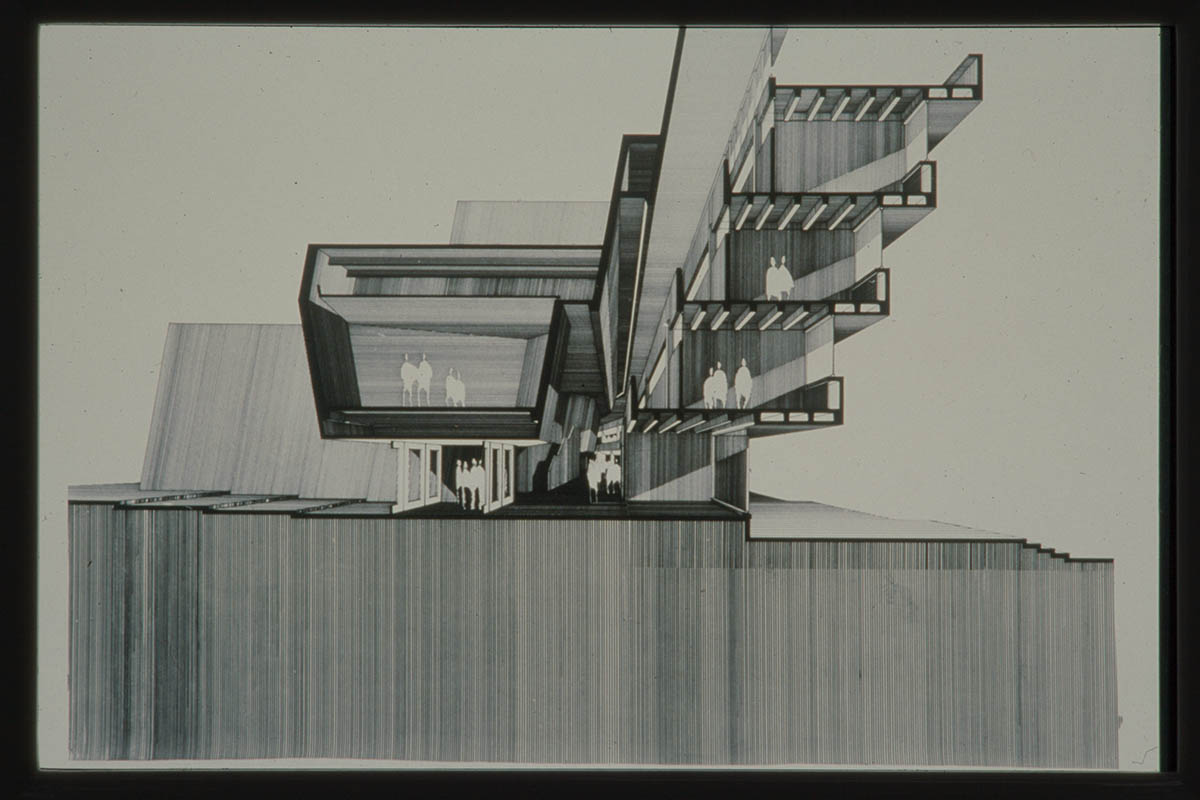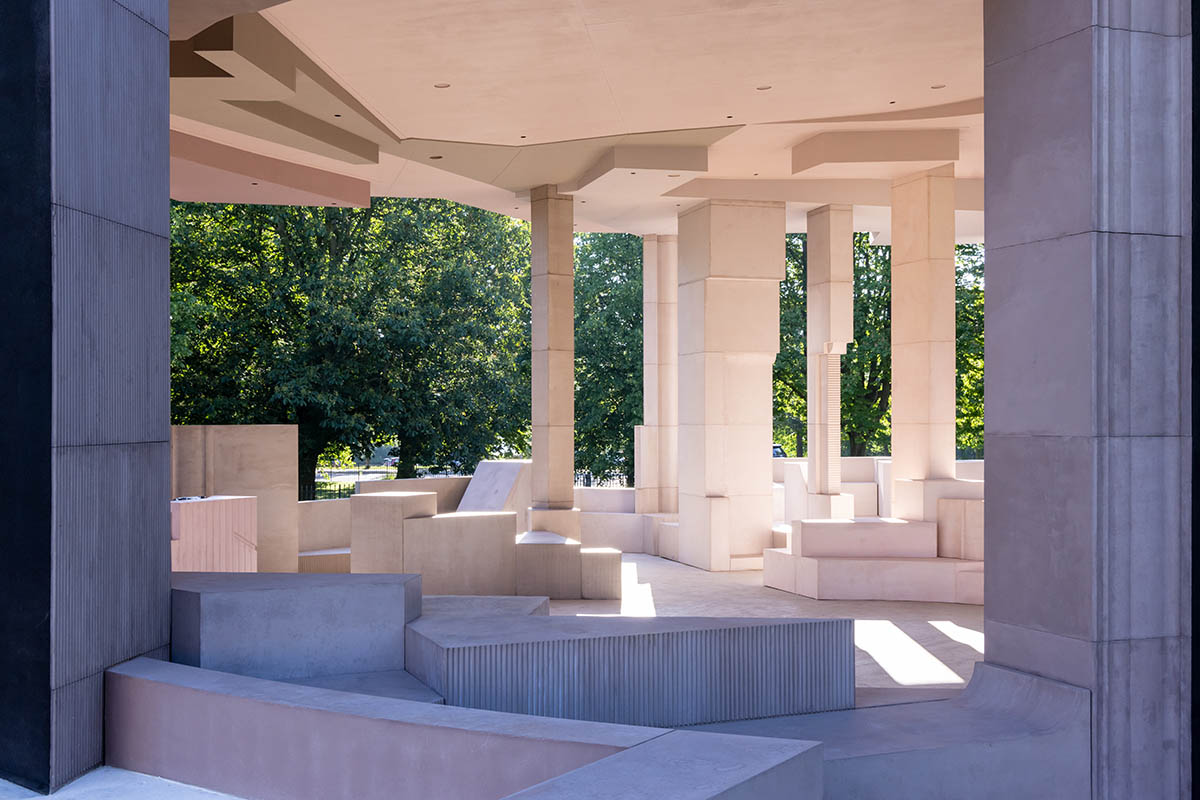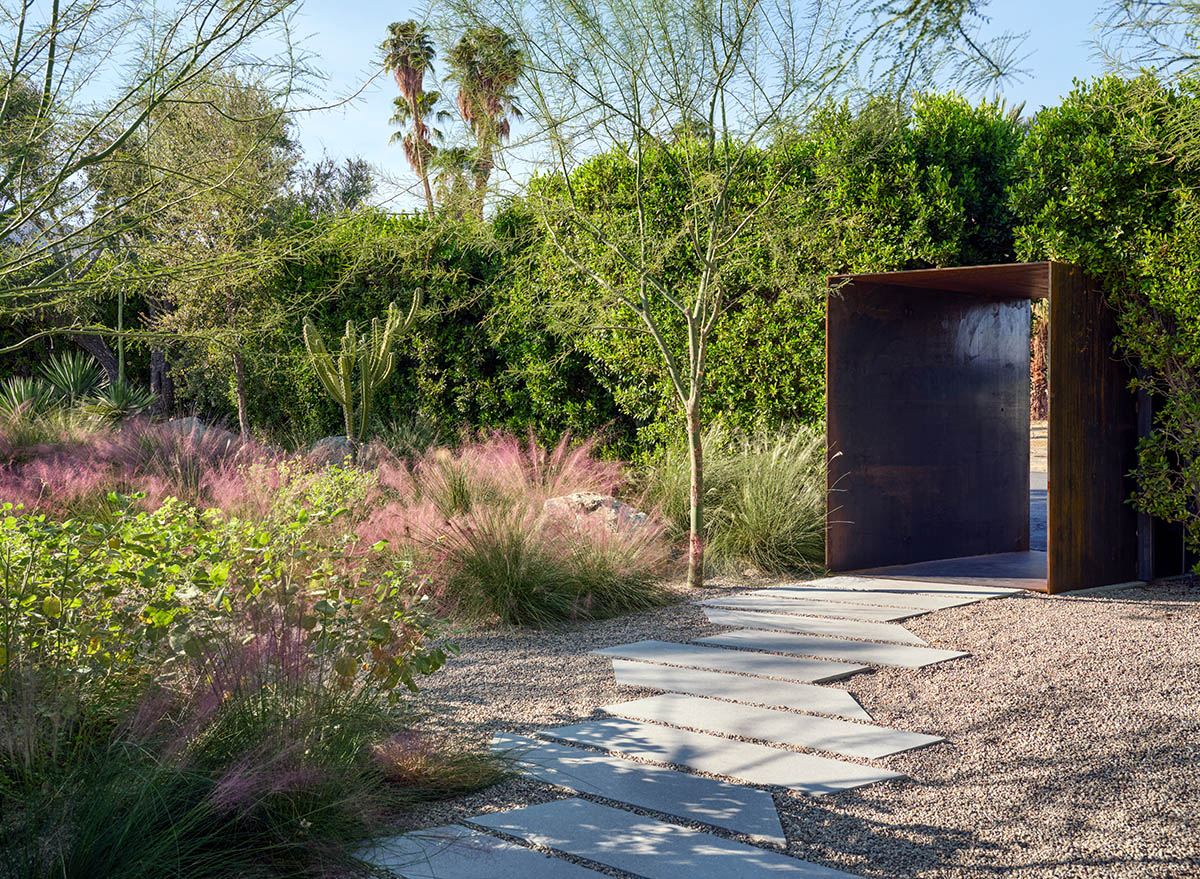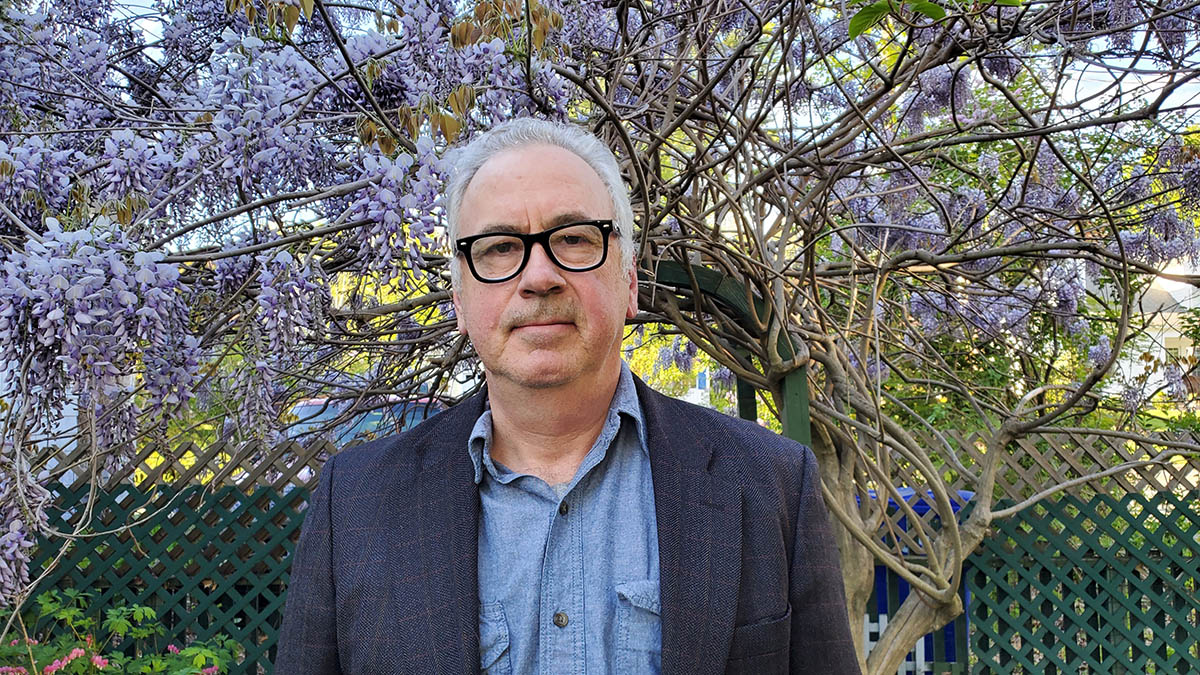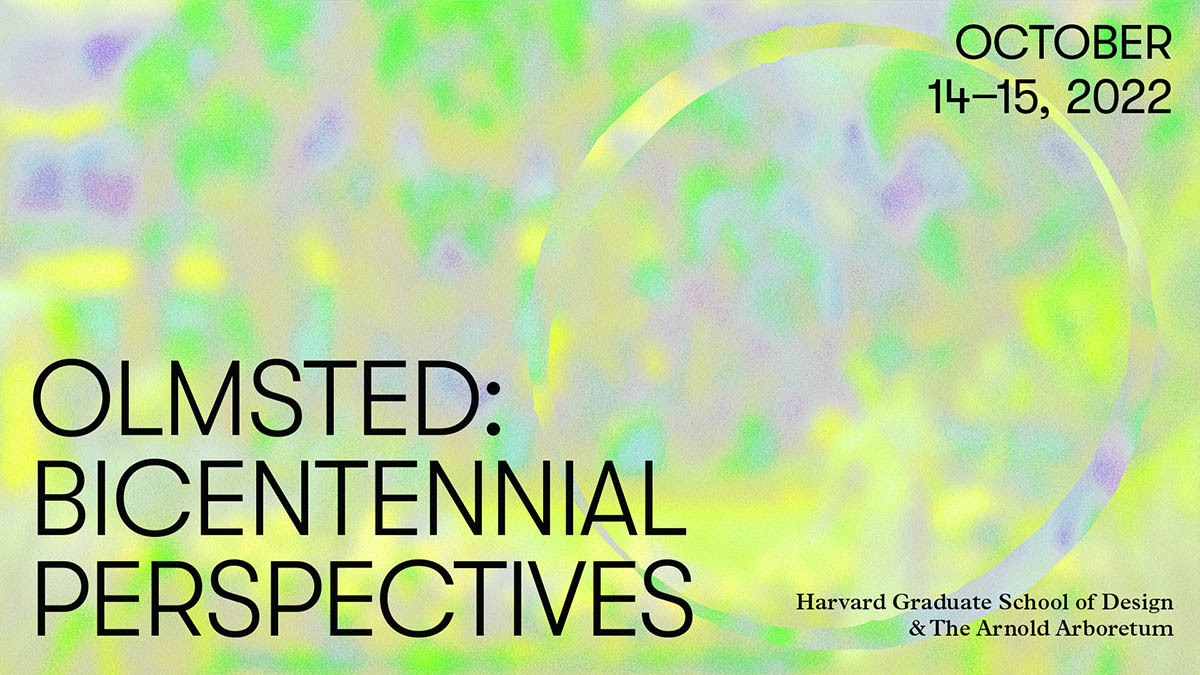Milton S. F. Curry, “Citizen Architect: Paradoxes of Race in Democratic Culture”
A recording of this event is available with audio description.
Event Description
Through a more robust framing of the “Citizen Architect” who is positioned as an innately egalitarian force in democratic space, the discipline of architecture can engage in democratizing cultural production and revitalizing subaltern thought. Race and Blackness, as theoretical vehicles, are essential towards rethinking the democratic present in the face of an apocalyptic and autocratic future. How does a racialized subject come to know themselves – physically, socially, psychically? The American postcolonial subject is operating amongst the vexed forces of intellectual and social history, the forces of the “humane horizon” (unattainable ideals of meritocracy, egalitarianism, freedom, liberty and equality), and the forces of lived experience (living under constant threat and precarity). In addition to laws and codified norms, democracy is organized around concepts of space and sociality that cohere polities to one another. The discipline of architecture has a significant role to play in reclaiming our ideals, actualizing change and performing transformative repair.
Speaker
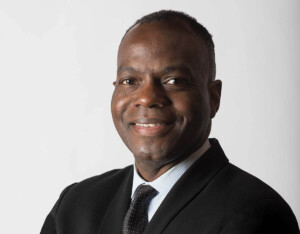
Milton S. F. Curry, MArch ’92, graduated from Harvard Graduate School of Design with a Masters in Architecture Post Professional degree; and from Cornell University with a Bachelors in Architecture. He is Professor of Architecture at the University of Southern California School of Architecture; where he was Dean and Della & Harry MacDonald Dean’s Chair in Architecture from 2017-2022. As dean at USC, he pivoted the School towards an ethos of the “Citizen Architect” that expands the architect’s role in societal issues, and initiated new academic and research programs focused on city design and pre-college access. He is currently on a one year research leave from USC and is a Visiting Scholar at Harvard GSD in Fall 2022.
With leadership and faculty positions at USC, University of Michigan Ann Arbor, Cornell University and Harvard GSD, Professor Curry is committed to the democratic project of the American university; and believes that linking the design arts, humanities and technology produces nonlinear creative thinking that synthesize humanist and technical know-how in ways that produce new knowledge. Professor Curry founded CriticalProductive and has produced seminal writings and creative work that link architecture to the pressing societal issues of post-war Americas – such as race, class, urbanization and postcolonialism.
Among many service commitments, he serves on the Museum of Modern Art New York Board of Trustees Acquisitions Committee on Architecture and Design, on the Abode Communities Board of Directors and Finance Committee, and is a General Services Administration Design Excellence National Peer Reviewer.
Paul Walker, “John Andrews: Architect of Uncommon Sense”
A recording of this event is available with audio description .
Event Description
John Andrews was the architect of a remarkable series of buildings starting with Scarborough College completed in Toronto’s outer suburbs in 1965 and ending with the Intelsat headquarters in Washington of 1988. In between came buildings in Canada, the United States, and Australia. This talk will focus on four of these projects: Scarborough, George Gund Hall for Harvard’s Graduate School of Design (1972), the Cameron Offices in Canberra (1976) – a bureaucratic city for 4000 workers, and the project that brought Andrews back to his native Australia – and Intelsat. It will explore several themes relevant to understanding his work: the significance of geography, connections between his work and that of other architects of his generation, Andrews’s tendency to consider buildings as urban forms, his attitudes to construction and to environmental issues in building, and the significance of teamwork to his practice. Andrews also adopted the role of advocate for architecture and design beyond just his own. While Andrews often claimed his architecture was a matter of pragmatics – common sense – the architectural strategies he employed were linked by their concern for human habitation and together produced complexities that evade reductivism. He was an architect of uncommon sense.
Paul Walker is also the curator of John Andrews: Architect of Uncommon Sense, on view in the Druker Design Gallery from October 28 – December 22. His lecture will be followed by a reception in the Gallery for the exhibition.
Speaker
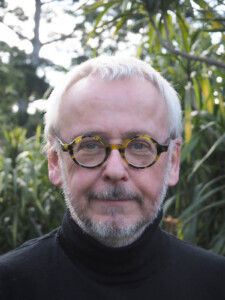
Paul Walker is a professor of architecture at the University of Melbourne where he teaches architectural history, theory, and design. He has written widely about modern and contemporary architecture in Australia and New Zealand and about British colonial architecture in various locations. Walker is a life member of the Society of Architectural Historians, Australia and New Zealand. With Justine Clark, he is the author of Looking for the Local: Architecture and the New Zealand Modern, Victoria University Press, Wellington (2000), and with Julia Gatley, Vertical Living: The Architectural Centre and the Remaking of Wellington , Auckland University Press (2014). His work has appeared in the Journal of Architecture, Fabrications, CLOG, Architecture Australia, and Volume. Walker is the editor and lead author of the John Andrews: Architect of Uncommon Sense , forthcoming from Harvard Design Press.
Sumayya Vally in conversation with Dean Sarah Whiting
A recording of this event is available with audio description .
Event Description
Sarah M. Whiting, Dean and Josep Lluís Sert Professor of Architecture, will sit down with architect Sumayya Vally for an intimate conversation about design practice, pedagogy, and research.
Speaker

Sumayya Vally was born in Pretoria, South Africa in 1990. Vally’s design, research, and pedagogical practice is searching for expression for hybrid identities and territory, particularly for African and Islamic conditions. Her design process is often forensic, and draws on the aural, performance and the overlooked as generative places of history and work.
She is the co-founder and principal of the award-winning architecture and research studio, Counterspace . A TIME100 Next List honouree, Sumayya Vally is named as shaping the future of the architectural canon and practice; and designer of the 20th Serpentine Pavilion (2020/2021), Vally is the youngest architect ever to be commissioned for the internationally renowned architecture programme. She has worked on initiating and developing Support Structures for Support Structures , a new fellowship programme launched at the Serpentine, which supports artists and collectives who support community through their work at the intersections of art and social justice, art and the archive, and art and ecology. In 2022 Sumayya Vally was selected by the World Economic Forum to be one of its Young Global Leaders, a community of the world’s most promising artists, researchers, entrepreneurs, activists, and political leaders.
As Artistic Director, Vally is currently working on curating the first Islamic Arts Biennale taking place in Jeddah in 2023. She is currently collaborating on the design of the Ellen Johnson Sirleaf Presidential Center for Women and Development in Monrovia, Liberia, the first presidential library dedicated to a female head of state, where she will oversee the scenography, pavilions, and exhibition spaces. She is also working on a garden and gathering place commemorating the 5th Pan-African Congress held in Manchester, UK, in 1945.
Sumayya’s practice operates adjacent to the academy. For six years she led the masters’ studio, Unit 12, at the Graduate School of Architecture, University of Johannesburg—founded by Professor Lesley Lokko, with the intent to create a curriculum for the African continent. She has lectured widely, most recently as Pelli Distinguished Visiting Lecturer at the School of Architecture, University of Illinois Urbana-Champaign.
Lucy Raven, “State Change and Old Gags”
Event Description
The GSD welcomes visual artist Lucy Raven to deliver the fall Rouse Visiting Artist Lecture.
In this presentation, artist Lucy Raven will present materials relating to several recent moving image installations, including Ready Mix, which was commissioned by and premiered at Dia Chelsea in 2021, and Demolition of a Wall (Album 1 and Album 2), which premiered at the 2022 Whitney Biennial and at WIELS. Together, these pieces explore the properties of extreme pressure and material state change occurring respectively at a concrete plant in central Idaho and an explosives range in southern New Mexico. They form the first two sections of a trilogy of “Westerns” Raven has been developing in locations throughout the Western United States.
For the Q+A, Raven will be joined by David Joselit , Chair of the Department of Art, Film, and Visual Studies at Harvard University.
Speaker
Lucy Raven was born in Tucson, Arizona, in 1977. She received a BFA in studio art and a BA in art history from the University of Arizona, Tucson, in 2000, and an MFA from Bard College’s Milton Avery Graduate School of the Arts, Annandale-on-Hudson, New York, in 2008. Her work has been exhibited in solo presentations at the Nevada Museum of Art, Reno (2010); Hammer Museum, Los Angeles (2012); Portikus, Frankfurt (2014); Yerba Buena Center for the Arts, San Francisco (2014); VOX centre de l’image contemporaine, Montreal (2015); Columbus Museum of Art, Ohio (2016); and Serpentine Galleries, London (2016–17). Select group shows include those at Mass MoCA, North Adams, Massachusetts (2008–09); Wexner Center for the Arts, Ohio State University, Columbus (2010); Whitney Museum of American Art, New York (2013); and Los Angeles County Museum of Art (2018–19). Additionally, Raven’s work was included in the 2012 Whitney Biennial, New York; 2016 Montreal Biennial; and 2018 Dhaka Art Summit, Bangladesh. With Vic Brooks and Evan Calder Williams, she is a founding member of 13BC, a moving-image research and production collective. Raven teaches at the Cooper Union School of Art in New York.
James A. Lord and Roderick Wyllie of Surfacedesign, “Wet + Dry: Landscapes of Resilience and Material Exploration”
A recording of this event is available with audio description.
Event Description
Surfacedesign is a landscape architecture and urban design firm based in San Francisco, California. This internationally award-winning practice focuses on creating dynamic parks, campuses, plazas, waterfronts, civic landscapes and private gardens. The firm’s approach emphasizes and celebrates the unique context and imaginative potential of each project. The studio’s design process is rooted in asking novel questions and listening to a site and its users – a process that has led to engaging and inspiring landscapes that are rugged, contemporary, and crafted.
Increasingly, water has become a central focus of all landscape interventions. Holistic, systems-based design thinking that actively engages water extremes—from drought to flooding/sea level rise— is at the core of Surfacedesign’s practice. Challenging the formal manifestations of municipal guidelines and standards for water management, each project engages water as an integral design element. James and Roderick will share a range of work from the residential to the infrastructural. These works celebrate water systems and explore how planting, topography and cultural narratives can reinforce water resiliency.
Speakers
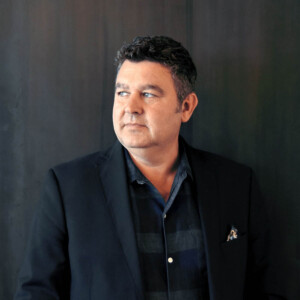
James A. Lord, FASLA
Partner, Surfacedesign Inc
James A. Lord is a founding partner of Surfacedesign, Inc. James’ innovative design approach and stewardship of the firm’s design practice has established Surfacedesign as an international leader in urban design and sustainability. He leads projects in New Zealand, Hawaii, Mexico, Los Angeles and the San Francisco Bay Area. James received his MLA from the Harvard Graduate School of Design and his BARCH from the University of Southern California.

Roderick Wyllie, FASLA
Partner, Surfacedesign Inc
Roderick Wyllie is an award-winning landscape architect and a founding partner of Surfacedesign, Inc. Roderick has led a variety of complex projects within the office, including the Uber Campus in Mission Bay, San Francisco’s Bayfront Park, The Land’s End Visitor Center, The Barnacles at Pier 9 and Expedia Global Headquarters in Seattle. His horticultural knowledge and passion for material authenticity reinforce craftsmanship and attention to detail into each project at Surfacedesign.
Ethan Carr, “Letting It Alone at Franklin Park: The Good, the Bad, and the Ugly”
A recording of this event is available with audio description.
Event Description
This year’s Frederick Law Olmsted Lecture, delivered by Ethan Carr, is also the keynote lecture for the conference Olmsted: Bicentennial Perspectives, October 14-15, 2022. On Friday, the conference will run from 10:00 AM – 7:00 PM; the Frederick Law Olmsted Lecture will take place from 5:30 – 7:00 PM that evening.
“Well, they have let it alone a good deal more than I thought they would!” Horace Greeley on his first visit to Central Park (according to Clarence Cook, 1869)
“We have let it alone more than most gardeners can. But never too much, hardly enough.” Frederick Law Olmsted to Calvert Vaux, 1887
Olmsted designed his most complete and innovative park system in Boston, including a “large park” that contained his most ambitious pastoral landscape. Often grouped with Central Park (1858) and Prospect Park (1865) as one of his three greatest urban parks, Boston’s Franklin Park (1885) cost less than a third as much to develop. But the desire to “let it alone” was more than a pecuniary impulse. Achieving more by doing less culminated an evolution in his design practice. The landscape of upland pastures and hanging woods persisted as an amplified version of what it had been: a characteristic passage of “rural” New England scenery. For Olmsted, letting it alone both preserved and transformed the landscape into an ideal setting for “receptive” recreations that improved individual wellbeing and built a sense of community in the modern city.
When the problem of low visitation to Franklin Park was identified at the end of the nineteenth century, Boston responded with the construction of the Franklin Park Zoo (1912) and successfully activated the park. But in the mid-twentieth century, a decline in the condition of the park drew an opposite response—another and very different way of letting it alone. Buildings and structures were left to deteriorate and landscape maintenance all but disappeared. Institutional racism influenced official policy: once Franklin Park was perceived as a place for Black people, city government no longer considered it worth maintaining. This fact has been obscured by histories that emphasize a perceived obsolescence of the design or the conflict of “active” and “passive” recreation as causes of the park’s supposed demise. These interpretations suggest that the park should be considered an abandoned ruin awaiting redevelopment. But Franklin Park was never abandoned. For over fifty years people in the communities around it have enjoyed the park, organized programming, and performed maintenance. The official neglect of Franklin Park is nevertheless one of great inequities in the city’s history, and new investment and design must address it—perhaps by finding a right way, again, to let it alone.
To attend this keynote address, please register for Olmsted: Bicentennial Perspectives.
Speaker
Ethan Carr, PhD, FASLA, is a Professor of Landscape Architecture and the Director of the Master of Landscape Architecture program at the University of Massachusetts, Amherst. He is a landscape historian and preservationist specializing in public landscapes. Three of his award-winning books, Wilderness by Design (University of Nebraska Press, 1998), Mission 66: Modernism and the National Park Dilemma (University of Massachusetts Press, 2007), and The Greatest Beach: A History of Cape Cod National Seashore (University of Georgia Press, 2019), describe the twentieth-century history of planning and design in the US national park system as a context for considering its future. Carr was the lead editor for The Early Boston Years, 1882-1890, Volume 8 of the Papers of Frederick Law Olmsted (2013). Carr co-wrote Olmsted and Yosemite: Civil War, Abolition, and the National Park Idea (Library Of American Landscape History, 2022) with Rolf Diamant, tracing the origins of the American park movement. His latest book, Boston’s Franklin Park: Olmsted, Recreation, and the Modern City (2023) reconsiders the history of this landmark urban park. Carr consults with landscape architecture firms that are developing plans and designs for historic landscapes.
Olmsted: Bicentennial Perspectives
Event Description
The Harvard University Graduate School of Design, in partnership with the Arnold Arboretum , will host a two-day academic conference as part of the national Olmsted 200 celebration. While Olmsted was central to the conceptual formation of the degree program in landscape architecture at Harvard University and the design of the Arnold Arboretum, the interpretive ambitions of the conference are anything but parochial.
“The Sesquicentennial of a Great American.” Under that unambiguous heading, in 1972 the Olmsted Sesquicentennial Committee elaborated its “simple” reasons for celebrating the living legacy of Frederick Law Olmsted: “to dedicate ourselves to the idea of human survival and to identify this dedication with America’s first and greatest environmentalist.”
Fifty years into our ongoing act of survival, it is time again to reconsider the image of this representative American. America has changed, and so too have its (shared?) notions of greatness, of identity, and certainly its understanding of the varied historical sources of environmentalism. To what ideas do we remain dedicated in this, the year of Olmsted’s bicentennial? The story of Olmsted is perhaps no longer so simple; arguably it is more relevant than ever.
The conference consists of six panels composed of scholars from a variety of disciplines engaged in critical research on both new and familiar areas of Olmsted study. National parks, suburban subdivisions, world’s expositions, battlefields, dispossessed communities, family homesteads, English gardens, slave states, city parks, scenic parkways, forests, and swamps are but some of the sites and scenes that will be examined from a diversity of perspectives.
Register for Day 1 of the conference using this link or the link on the right-hand side of the page. In-person tickets for Day 2 are completely sold out. To engage with day 2, please watch the live stream.
Conference Overview
Friday, October 14
Harvard GSD, Piper Auditorium
48 Quincy St., Cambridge, MA 02138
Doors open at 9:30 am
Welcome
10:00 – 10:05Sarah Whiting, Dean and Josep Lluís Sert Professor of Architecture
Opening Remarks
10:05 am – 10:30 am
Edward Eigen
Panel 1: The (Un)making of America
10:30 am – 12:00 pm
Moderated by Thaisa Way
- Thomas J. Brown, The Shaw Memorial and the Boston Park System
- John D. Davis, Volunteering Olmsted
- Sara Zewde, Finding Frederick Law Olmsted in Cotton’s Kingdom
Panel 2: Campuses, Collectives, and Unsettlements
1:00 pm – 2:30 pm
Moderated by Annie Simpson
- Yvonne Elet, The Campus Green
- Christine Edstrom O’Hara, Still Chasing Water: Frederick Law Olmsted, Theory and Practice in the Arid West
- Alexander Manevitz, The Social Destruction of Seneca Village: Environmental Propaganda and the Creation of Central Park
Panel 3: …whithersoever thou goest
3:00 pm – 4:30 pm
Moderated by Sarah Moses
- Diana Martinez, Learning from Colonial Landscapes: Empire and the “Genius of Place”
- Desiree Valadares, Olmsted Across Oceans: Fred’s Maritime Voyages and Transoceanic Crossings in 1843–44
- Anette Freytag, The American Grand Tour – Fruitful Exchange Processes to Foster Democratic Spaces
Keynote Address
5:00 pm – 7:00 pm
Keynote Introduction by Gary Hilderbrand, Anticipating the Renewal of Olmsted’s Franklin Park
Ethan Carr, Letting It Alone at Franklin Park: The Good, the Bad, and the Ugly
Saturday, October 15
The Arnold Arboretum, Weld Hill Research Building
1300 Centre Street, Boston, MA 02131
Doors open at 10:00 am
Panel 1: A Clearing in the Woods
10:30 am – 12:00 pm
Moderated by Hugo Betting
- William (Ned) Friedman, Director of the Arnold Arboretum of Harvard University and Arnold Professor of Organismic and Evolutionary Biology, Arnold Arboretum at 150 – Looking Ahead to the Next Century
- Rosetta S. Elkin, Out of Place: Landscape Advocacy at the Arnold Arboretum
- Mary Kuhn, Approaching Olmsted’s Forests
Panel 2: Roads, Barriers, and Democratic Vistas
1:00 pm – 2:30 pm
Moderated by Fadi Masoud
- Sara Jacobs, Landscapes of Racialization: Visualizing Race, Nature, and Urban Landscapes after Olmsted
- Tim Davis, FLO in the Driver’s Seat: The Primacy of Roads in Olmsted’s Vision of Parks, Cities and Society
- Kathleen John-Alder, The Promised Land: Security, Democracy, and the National Mall
Panel 3: The Several Selves of Frederick Law Olmsted
3:00 pm – 4:30 pm
Moderated by Samantha Page
- Edward Eigen, Papering Over Olmsted
- Catherine Seavitt, Seeds, Grafts, and Offshoots: Olmsted on (and off) Staten Island, 1848–1857
- Charles Birnbaum, The Road to the Olmsted Renaissance
Reception
4:30 pm – 6:30 pm
Transportation and Access
Day 1 of the conference takes place at the GSD. The closest MBTA Red Line station is Harvard Square. Metered street parking is available but is extremely limited. We highly encourage guests to take public transportation.
Day 2 takes place at the Arnold Arboretum Weld Hill Research Building. Detailed instructions for getting to Weld Hill by public transportation or car are available on the Arboretum Website
. Free parking is available in the lot in the front of the Weld Hill building.
* The GSD will offer a free shuttle bus service from Gund Hall to the Arboretum. More information will be shared directly with conference registrants.
Accessibility questions? Visit the GSD’s Accessibility at Public Programs webpage to find information for Friday. Visit the Arboretum’s Accessibility webpage to find more information for Saturday. Still have questions? Email [email protected].
Speakers
Charles A. Birnbaum, FASLA, FAAR, is President and CEO of The Cultural Landscape Foundation (TCLF). Prior to creating TCLF, he spent fifteen years as coordinator at the National Park Service Historic Landscape Initiative and a decade in private practice in New York City with a focus on cultural landscapes and urban design. Birnbaum has authored and edited numerous publications including Modern Landscapes: Transition and Transformation (Princeton University Press), Shaping the American Landscape (University of Virginia Press, 2009), Design with Culture (University of Virginia Press, 2005), Preserving Modern Landscape Architecture (Spacemaker Press, 2006), and the forthcoming, Experiencing Olmsted (Timberpress, 2022). Birnbaum was a Loeb Fellow at Harvard’s GSD, and a Rome Prize recipient. He was awarded ASLA’s LaGasse Medal in 2008, President’s Medal in 2009 and the ASLA Medal (The Society’s highest honor) in 2018. He served as a Lecturer in Landscape Architecture at Harvard’s GSD (2020–); Visiting Professor, Columbia University’s Graduate School of Architecture (2011–16); and Glimcher Distinguished Professor, Ohio State University (2007). From 2010 to 2018, Birnbaum was a frequent contributor to The Huffington Post. In 2021, TCLF unveiled The Cornelia Hahn Oberlander International Prize in Landscape Architecture, a permanently endowed Prize with a $100,000 purse.
Thomas J. Brown received his education at Harvard University and has taught at the University of South Carolina since 1996. He addressed Olmsted’s work with the United States Sanitary Commission in Dorothea Dix, New England Reformer (Harvard University Press, 1998). His subsequent research has focused on Civil War remembrance. Brown is the author of Civil War Canon: Sites of Confederate Memory in South Carolina (University of North Carolina Press, 2015) and Civil War Monuments and the Militarization of America (University of North Carolina Press, 2019), which received the annual book prize of the Society of Civil War Historians. He is working on a book about the Shaw/54th Memorial, on which he has published essays in his co-edited Hope and Glory: Essays on the Legacy of the 54th Massachusetts Regiment (University of Massachusetts Press, 2001) and The Civil War in Art and Memory (National Gallery of Art, 2016).
Ethan Carr, PhD, FASLA, is a Professor of Landscape Architecture and the Director of the Master’s of Landscape Architecture program at the University of Massachusetts, Amherst. He is a landscape historian and preservationist specializing in public landscapes. Three of his award-winning books, Wilderness by Design (University of Nebraska Press, 1998), Mission 66: Modernism and the National Park Dilemma (University of Massachusetts Press, 2007), and The Greatest Beach: A History of Cape Cod National Seashore (University of Georgia Press, 2019), describe the twentieth-century history of planning and design in the US national park system as a context for considering its future. Carr was the lead editor for The Early Boston Years, 1882-1890, Volume 8 of the Papers of Frederick Law Olmsted (2013). Carr co-wrote Olmsted and Yosemite: Civil War, Abolition, and the National Park Idea (Library Of American Landscape History, 2022) with Rolf Diamant, tracing the origins of the American park movement. His latest book, Boston’s Franklin Park: Olmsted, Recreation, and the Modern City (2023) reconsiders the history of this landmark urban park. Carr consults with landscape architecture firms developing plans and designs for historic landscapes.
John D. Davis, PhD, is an environmental and architectural historian and Assistant Professor of Landscape Architecture at the Knowlton School, Ohio State University. His articles and essays on landscape historiography and military engineering have been published internationally. He is the co-editor of the volume Military Landscapes (Dumbarton Oaks, 2021). Current projects include editing a volume on architecture and landscape in the Greater Caribbean, and a book on engineering and landscape in the US South during Reconstruction.
Tim Davis is a historian for the US National Park Service, where he has focused on cultural landscape research, documentation, and preservation. He is the author of the award-winning volume National Park Roads: A Legacy in the American Landscape (University of Virginia Press, 2016) and co-editor of America’s National Park Roads and Parkways: Drawings from the Historic American Engineering Record (Johns Hopkins University Press, 2004). His writings have appeared in numerous journals and scholarly anthologies, including Landscape Journal, Studies in the History of Gardens and Designed Landscapes, Perspectives in Vernacular Architecture, Drawn to Landscape: The Pioneering Work of J. B. Jackson, and Places of Commemoration, Search for Identity and Landscape Design. He received his undergraduate degree in visual and environmental studies from Harvard College and PhD in American civilization from the University of Texas, Austin. Along with his NPS work, he has engaged a wide range of topics, from strip malls, satellite dishes, and trailer parks to the evolution of cultural landscape photography and the complex and often-contested relationships between vernacular and professionally designed landscapes. He is currently working on a cultural history and visual documentation of California’s John Muir Trail.
Edward Eigen is Senior Lecturer in the History of Landscape and Architecture at the Harvard University Graduate School of Design. His scholarly work focuses on intersections of the human and natural sciences with the built environment in the long nineteenth century. His book, On Accident: Episodes in Architecture and Landscape, was published by the MIT Press in 2018. Currently he is examining landscapes associated with the modern American presidency, including the “grassy knoll.” His recent essays on Olmsted examine questions of race, ornithology, piracy, drafting tools, and friction.
Yvonne Elet focuses her research on intermedial designs for art, architecture, landscape, and urbanism. Her first book was Architectural Invention in Renaissance Rome: Artists, Humanists, and the Planning of Raphael’s Villa Madama (Cambridge University Press, 2017), and she is currently completing a book on the entry zone to Rome in the interwar period, titled Urban Landscape in the Third Rome: Raphael’s Villa and Mussolini’s Forum. She is also working on a book about stucco in the art and architecture of early modern Italy, and a project on Raphael as landscape architect. Her articles appear in the Journal of the Society of Architectural Historians, Journal of Gardens and Designed Landscapes, Journal of Planning History, and I Tatti Studies in the Italian Renaissance. Her work has been supported by the ACLS, Getty, CASVA, Mellon Foundation at the Frick Collection, and the Metropolitan Museum. She has been a visiting professor at the Universities of Bologna and Urbino, and visiting scholar at the Max-Planck-Institut, Berlin. She received her PhD from the Institute of Fine Arts, New York University, and a BS from Yale. Elet also teaches and publishes on Vassar campus history , including the work of Beatrix Farrand.
Rosetta S. Elkin is the first Academic Director of the newly established program in Landscape Architecture at Pratt Institute, which aims to advance land-based research at the cutting edge of climate and public change. Prior to establishing the MLA at Pratt, Elkin taught at McGill University, the Harvard Graduate School of Design, and the Acadamie Rietveld. Elkin is the founding Principal of Practice Landscape , a collaborative studio that prioritizes planting strategies, garden-making, public exhibition, open access publishing, and horticultural research to promote a more thoughtful and accountable design agenda. At Harvard’s Arnold Arboretum , Elkin is a Research Associate, focused on elevating the role of plants in design. Elkin is the author of Plant Life: The Entangled Politics of Afforestation (University of Minnesota Press, 2022) which describes the geo-political ambitions of tree planting programs. Her first publication,Tiny Taxonomy (Actar, 2017), reflects on the scale of individual plants through a reading of three garden installations. Elkin’s forthcoming book, Landscapes of Retreat (K. Verlag, 2023), is a fieldwork-based portrait of climate adaptation around the world. Her published work is currently supported by the Graham Foundation for the Arts, and Harvard’s Climate Solutions Fund. In 2018, Elkin received the Garden Club of America Rome Prize in landscape architecture and continues to exhibit widely in venues such as the Victoria & Albert Museum, Les Jardins de Metis, the Chelsea Festival, and the Isabella Stewart Gardner Museum.
Anette Freytag is a Professor of Landscape Architecture (History, Theory and Design) at Rutgers University and an award-winning scholar, educator, and critic. She is a graduate of the University of Vienna and the ETH Zurich. Her research focuses on designed landscapes from the nineteenth century to the contemporary practice with a particular focus on topology and phenomenology. In 2019, she co-founded the Arts Integration Research Collaborative (AIR), which prioritizes creative placemaking to foster spatial justice through multidisciplinary research and curricular agendas that benefit and strengthen the local communities of their arts-integrated interventions . Her latest book The Landscapes of Dieter Kienast (gta, 2021) focuses on the Swiss landscape architect Dieter Kienast (1945–1998), a key figure in European landscape architecture. He designed spaces to make the dissolving opposition between city and countryside legible and to enable aesthetic experience to help cope with increasingly complex everyday life. Critique of urban planning, processes of participation and the significance of spontaneous urban vegetation played just as much a role in these discussions as did art, literature and architecture. Freytag’s books have been honored with the J. B. Jackson Book Prize, the European Garden Book Award, the DAM Architectural Book Award and many more.
William (Ned) Friedman is the Arnold Professor of Organismic and Evolutionary Biology at Harvard University and the eighth Director of the Arnold Arboretum of Harvard University in its nearly 150-year history. Friedman’s scholarly studies have fundamentally altered century-old views of the earliest phases of the evolution of flowering plants, Darwin’s so-called “abominable mystery.” He is also deeply interested in the history of early (pre-Darwinian) evolutionary thought and is particularly focused on the largely forgotten contributions of horticulturists and botanists. As Director of the Arnold Arboretum, Friedman has worked to expand the Arboretum’s societal impact through diverse initiatives in public programming, digital communications, enhanced dialogue between scientists and the public, the promotion of scientific scholarship within the living collections, and a reinvigoration of the long-standing relationship between the Arboretum and the biodiversity of Asia. As Friedman continues to lead the Arboretum forward to its sesquicentennial year in 2022 and the launch of the Arnold’s next century of impact, two fundamental priorities will dominate the Arboretum’s focus: doubling down on environmental justice and spatial equity and committing to do everything possible to combat climate change and extinction. The Arnold Arboretum remains one of the relatively few botanical gardens or arboreta that is free to all every day of the year. As Friedman has emphasized, access to nature, especially in an urban environment, is a human right, one with implications for health and well-being, connection to beauty and complexity, and the incredible restorative powers of a pristine Olmsted design.
Gary Hilderbrand, FASLA, FAAR, is the Peter Louis Hornbeck Professor in Practice and Chair of the Department of Landscape Architecture, Harvard Graduate School of Design. He is also principal and founder of Reed Hilderbrand Landscape Architects. Hilderbrand is a fellow and resident of the American Academy in Rome. He received the Design Medal from ASLA in 2017. His widely acclaimed publications include The Miller Garden: Icon of Modernism (Spacemaker Press, 1999) and Visible | Invisible: Landscape Works of Reed Hilderbrand (Metropolis Books, 2013).
Sara Jacobs is an Assistant Professor of Landscape Architecture at the University of British Columbia, where she is grateful to live and work on the unceded traditional territories of the Musqueam, Squamish, and Tsleil-Waututh Nations. Connecting across her training in landscape architecture, environmental history, and geography, Jacobs’s research considers how attending to interconnected histories of landscape, settler-colonialism, and racialization allows for rethinking dominant environmental relations within contested landscapes. Her design work has been recognized internationally, including from the American Society of Landscape Architects, and recent research has been supported by the Graham Foundation and the Center for Land Use Interpretation. Jacobs’s writing is published in the Journal of Landscape Architecture, Journal of the Society of Architectural Historians, Journal of Architectural Education, and SITE Magazine. Prior to joining the faculty at UBC, she was the Myles H. Thaler Visiting Assistant Professor at the University of Virginia. Jacobs has an MLA from Harvard University and PhD in History and Theory of the Built Environment from the University of Washington.
Kathleen John–Alder is Associate Professor in the Department of Landscape Architecture at Rutgers University and a Fellow of the American Society of Landscape Architects. A practicing landscape architect, with degrees from Oberlin College, Rutgers University, and the Yale School of Architecture, her scholarly research bridges disciplinary boundaries in order to explore the transformative role of ecology and environmentalism in the discourse of mid-twentieth-century landscape design and its impact upon contemporary practice. John-Alder is the author of Ian McHarg and the Search for Ideal Order (Routledge, 2019), and she has published articles in Landscape Journal, The Journal of Planning History, JoLA, Studies in the History of Gardens and Designed Landscapes, Site/Lines and Manifest. Her work has also received design and research awards from the Van Alan Institute, the National Park Service, and the American Society of Landscape Architects.
Mary Kuhn is an Assistant Professor in the English Department at the University of Virginia. She is a scholar of nineteenth-century American literature and the environmental humanities. Her first book, The Garden Politic (forthcoming from New York University Press, 2023), focuses on the literary, cultural, and political significance of plant life in nineteenth-century America. Her work has also appeared in PMLA, ELH, American Literature and Common-place. She is currently working on a second project about the cultural history of Paris Green, an arsenic-based pigment that became a popular insecticide in the late nineteenth century.
Alexander Manevitz is a scholar, public historian, educator, and consultant on the histories of freedom, race, and urban development in the United States, with a particular focus on New York City and Seneca Village. He is currently an Assistant Professor of History at Baruch College, City University of New York and has previously held visiting faculty and postdoctoral positions at the New-York Historical Society, the New School, and Trinity College since completing his PhD from New York University in 2016. His book manuscript, The Rise and Fall of Seneca Village, is under contract with Cornell University Press and you can find his work in The Journal of Urban History and The Washington Post. You can also look for him on Twitter: @historicities
Diana Martinez is Assistant Professor and Director of Architectural Studies in the Department of History of Art and Architecture at Tufts University, where she holds a secondary appointment in the Department for the Study of Race, Colonialism, and Diaspora. She is completing a book manuscript, “Concrete Colonialism: Architecture, Infrastructure, Urbanism, Racial Capitalism, and the American Colonial Project in the Philippines.” Her work is published in The Avery Review, Comparative Studies of South Asia, Africa, and the Middle East, and in the collected volume Architecture in Development with the Aggregate Architectural History Collaborative (Routledge, 2021).
Christine Edstrom O’Hara is Professor in Landscape Architecture at Cal Poly, San Luis Obispo, with research that focuses on landscape history and historic preservation. She holds degrees from Stanford University in English, a Master’s in Landscape Architecture and Preservation Planning from University of Washington, and a PhD in Landscape Architecture from University of Edinburgh. With over twenty years of research on the Olmsted firm, both her master’s thesis and dissertation analyzed the Olmsted Brothers’ Southern California practice and the firm’s ecological approach to design. O’Hara has published essays in The Journal for the Society of Architectural Historians, Landscape Journal, Pacific Horticulture, Shaping the American Landscape, and is editor of Essential Eden (Santa Monica: Angel City Press, 2023), a compendium of essays on California history through the lens of cultural landscapes. She is the former president of the California Garden & Landscape History Society and serves on the advisory council for the National Association for Olmsted Parks.
Catherine Seavitt Nordenson is a Professor and Director of the Master of Landscape Architecture program at the Spitzer School of Architecture, City College of New York. A registered architect and landscape architect, she is a graduate of the Cooper Union and Princeton University, a fellow of the American Academy in Rome and the American Society of Landscape Architects, and a recipient of a Fulbright Fellowship for research in Brazil. Her work explores adaptation to climate change in urban environments and the novel transformation of landscape restoration practices. She also examines the intersection of political power, environmental activism, and public health, particularly as seen through the design of equitable public space and policy. Seavitt’s books include Depositions: Roberto Burle Marx and Public Landscapes under Dictatorship (University of Texas Press, 2018), Structures of Coastal Resilience (Island Press, 2018), and On the Water: Palisade Bay (Hatje Cantz, 2010). She is the founding faculty editor of the City College landscape journal PLOT. Her essays have been published widely, including the journals Architectural Review, Artforum, Avery Review, Harvard Design Magazine, JoLA, LA+, Landscape Architecture Magazine, and Topos. You can find her on Twitter: @cseavitt
Desiree Valadares is an architectural historian and heritage practitioner trained in landscape architecture. She received her PhD from the University of California, Berkeley in Architecture: History, Theory and Society. She writes about territoriality, oceanic geographies and empire in Canada and the US with a focus on the aftermath of Asian migration (wartime forced relocation) and Indigenous intersections in the transpacific – Hawaiʻi, Alaska, and British Columbia. Her research is supported by the Social Science and Humanities Research Council of Canada, the Graham Foundation for the Fine Arts, the Canada Council for the Arts, UC Berkeley Regent’s fellowship and the Canadian Centre for Architecture. Valadares is an Assistant Professor at the University of British Columbia’s Geography Department and an Affiliate Faculty in Asian Canadian and Asian Migration Studies.
Sara Zewde is founding principal of Studio Zewde, a design firm in New York City practicing landscape architecture, urbanism, and public art. The studio is devoted to creating enduring places where people belong. Named to Architectural Digest’s AD100 and an Emerging Voice by the Architectural League of New York, the firm is celebrated for its design methods that sync culture, ecology, and craft. In parallel with practice, Zewde serves as Assistant Professor of Practice at Harvard University Graduate School of Design. Zewde was named the 2014 National Olmsted Scholar by the Landscape Architecture Foundation, a 2016 Artist-in-Residence at the Robert Rauschenberg Foundation, and a 2020 United States Artists Fellow. Sara holds a master’s of landscape architecture from the Harvard University Graduate School of Design, a master’s of city planning from MIT, and a BA in sociology and statistics from Boston University.

